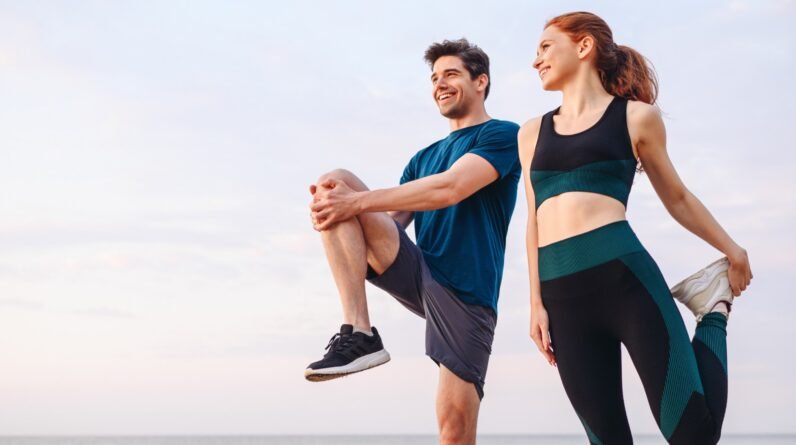
When was the last time you strength trained? If you’re not big on lifting weights, you might be thinking, “uh…never?” Or you could be wondering whether something like yoga, kickboxing, or other bodyweight workouts can “count” as strength training.
The truth is, you don’t need to lay a finger on a dumbbell or barbell to make gains. “In order to get stronger, we simply need to recruit and fatigue our muscle fibers,” explains certified exercise physiologist Luke Carlson, CEP, CEO and founder of Discover Strength.
This can be done using machines, free weights, resistance bands, or just your body weight, he says. That’s right: Just your body weight.
Not convinced? Keep reading as experts explain why bodyweight workouts can help you build strength and how to ensure they check the resistance training box.
Do bodyweight workouts ‘count’ as strength training?
The answer is a resounding yes. “Bodyweight workouts definitely count as strength training,” says certified personal trainer Nicole Thompson, CPT.
Rather than using equipment to provide external resistance for your muscles to work against, these workouts utilize the weight of your body. “Exercises like push-ups, pull-ups, and squats are classic examples of bodyweight exercises that effectively train various muscle groups,” Thompson says. “Just like traditional weightlifting, bodyweight exercises can stimulate muscle growth, enhance muscular endurance, and improve overall health.”
Though heavy weights can help you get stronger and build muscle, they’re not necessary. Take this 2023 study1 published in Experimental Physiology, for example: Two small groups of healthy adults were assigned to do either bodyweight or free-weight resistance training for eight weeks, and the researchers found that both groups significantly increased the size of their muscles.
Another small study2 published in August 2023 in Scientific Reports on young women compared six weeks of progressive bodyweight squat training to six weeks of barbell back squat training and found that both groups experienced similar gains in muscle strength and size.
“The research is conclusive that the amount of weight we lift isn’t the real key to improving strength,” Carlson explains. “The key is to push to the point, or very close to the point, of momentary muscle failure.” Momentary muscle failure is when your muscles are so tired you can’t do any more reps.
Researchers hypothesize that fatiguing your muscles to this extent results in the greatest muscle fiber activation, which helps maximize muscle adaptations. Fatiguing your muscles appears to be even more important when training with lighter loads, as in the case of bodyweight training.
For people who are already well trained, these types of workouts might seem too easy to reach muscular fatigue, but this is a common misconception. There are so many ways to progress bodyweight moves so you’re effectively challenging yourself. Air squats might be easy for intermediate to advanced athletes, but just think about how hard it is to bang out pull-ups, push-ups, box jumps, or pistol squats for reps.
“To make exercises more difficult or break through plateaus, you can use the FITT principle: Frequency, Intensity, Time, and Type,” Thompson says. For example, you can manipulate these factors during bodyweight training in any number of ways:
- Increase the number of reps or sets
- Increase the intensity of the move (i.e. adding a jump to squats or a clap to push-ups)
- Adjust the leverage point (i.e., elevating your feet during push-ups or shifting from a forearm plank to a high plank)
- Incorporate unilateral exercises (which use one side of the body at a time)
- Increase time under tension, like adding isometric holds (e.g., holding a pull-up at the top position or a plank for longer)
- Decrease rest time to increase workout density and intensity
If you feel like exercises are too easy, you’re never getting sore anymore, or you’re results are plateauing despite working out consistently, it may be time to modify your routine, Thompson says. You may need to play with some of the above variables to keep upping the demand on your muscles, or it’s possible that bodyweight workouts just aren’t enough for you anymore.
Bodyweight workouts can undoubtedly help you build strength, but they do have limitations. If you’re no longer feeling challenged without external resistance and you’ve tried all sorts of tricks to level up the moves, it could be time to pick up some bands or weights.
“Bodyweight exercises can stimulate muscle growth, enhance muscular endurance, and improve overall health.” —Nicole Thompson, CPT
Other perks of bodyweight workouts
Aside from helping you build strength and muscle, bodyweight workouts also have several other benefits for your body and brain.
For one, bodyweight moves are generally functional fitness all-stars. “Many bodyweight exercises mimic activities of daily living, improving the ease of performing everyday tasks,” Thompson says. They foster a stronger mind-body connection, enhancing body awareness, balance, coordination, and control, which can improve overall athleticism, she adds.
Many bodyweight moves are compound exercises (which work multiple muscle groups) and also engage the core, which can have a cascade of positive effects, like improving posture, balance, and stability, Thompson says.
Bodyweight workouts can also double as cardio—especially when you add plyometric exercises, increase your rep speed, and reduce rest time. For example, one small April 2021 study4 published in the International Journal of Exercise Science found that just 11 minutes of bodyweight training (six exercises with active recovery in between) significantly improved cardiorespiratory health in inactive adults.
And if you’ve ever done a bodyweight HIIT workout, you know there’s no limit to the intensity possible; another study5, published in July 2021 in Frontiers in Sports and Active Living, found that four weeks of bodyweight HIIT improves cardiorespiratory fitness in healthy young adults.
Outside of their physiological effects, bodyweight workouts also have the bonus of being convenient, accessible, and cost-effective. “They can be done almost anywhere, anytime, without needing gym equipment, making it easier to maintain consistency,” Thompson says.
Finally, bodyweight workouts are highly versatile and can be modified for any fitness level, Thompsons says. And when you bring in tools like a pull-up bar, step, bench, workout sliders, or suspension trainer (like a TRX) that help you use your body weight in new ways, the options become virtually endless.
The bottom line
Don’t discount bodyweight workouts for building strength. As long as you’re taking your muscles to the brink while training, you’re making gains.
“The research is clear that regardless of the goal, the approach to strength training can be pretty similar,” Carlson says. “Years ago, we assumed that the amount of weight we used, the number of reps we performed, or the type of equipment we used significantly influenced our results.” Now, we know that the most important thing is how hard you’re working.
To effectively incorporate bodyweight strength workouts into your routine, it’s a good idea to create a balanced program that includes exercises targeting all major muscle groups: upper body, lower body, and core, Thompson says. Aim for at least two to three sessions per week, allowing rest days for recovery.
Just because bodyweight workouts are effective for building strength doesn’t mean weights are evil or that you need to toss every other type of workout in the trash. “Mixing bodyweight exercises with cardio or flexibility training can create a well-rounded fitness routine. This approach helps prevent burnout and monotony and keeps your workouts fun and engaging,” Thompson adds.
If this feels too hard to put into practice on your own, consider working with an exercise professional to design a program tailored to your goals and abilities. “They can help you stay consistent by providing accountability and guidance while safely building strength,” Thompson says. Stick with bodyweight workouts, and you might find yourself surprisingly jacked—just don’t say we didn’t warn you.
Well+Good articles reference scientific, reliable, recent, robust studies to back up the information we share. You can trust us along your wellness journey.
- Ogawa M, Hashimoto Y, Mochizuki Y, Inoguchi T, Kouzuma A, Deguchi M, Saito M, Homma H, Kikuchi N, Okamoto T. Effects of free weight and body mass-based resistance training on thigh muscle size, strength and intramuscular fat in healthy young and middle-aged individuals. Exp Physiol. 2023 Jul;108(7):975-985. doi: 10.1113/EP090655. Epub 2023 May 3. PMID: 37133323; PMCID: PMC10988481.
- Wei, W., Zhu, J., Ren, S. et al. Effects of progressive body-weight versus barbell back squat training on strength, hypertrophy and body fat among sedentary young women. Sci Rep 13, 13505 (2023). https://doi.org/10.1038/s41598-023-40319-x
- Nóbrega SR, Libardi CA. Is Resistance Training to Muscular Failure Necessary? Front Physiol. 2016 Jan 29;7:10. doi: 10.3389/fphys.2016.00010. PMID: 26858654; PMCID: PMC4731492.
- Archila LR, Bostad W, Joyner MJ, Gibala MJ. Simple Bodyweight Training Improves Cardiorespiratory Fitness with Minimal Time Commitment: A Contemporary Application of the 5BX Approach. Int J Exerc Sci. 2021 Apr 1;14(3):93-100. PMID: 34055156; PMCID: PMC8136567.
- Sian TS, Inns T, Gates A, Doleman B, Gharahdaghi N, Atherton PJ, Lund JN, Phillips BE. Short-Term, Equipment-Free High Intensity Interval Training Elicits Significant Improvements in Cardiorespiratory Fitness Irrespective of Supervision in Early Adulthood. Front Sports Act Living. 2021 Jul 26;3:697518. doi: 10.3389/fspor.2021.697518. PMID: 34381998; PMCID: PMC8349982.







